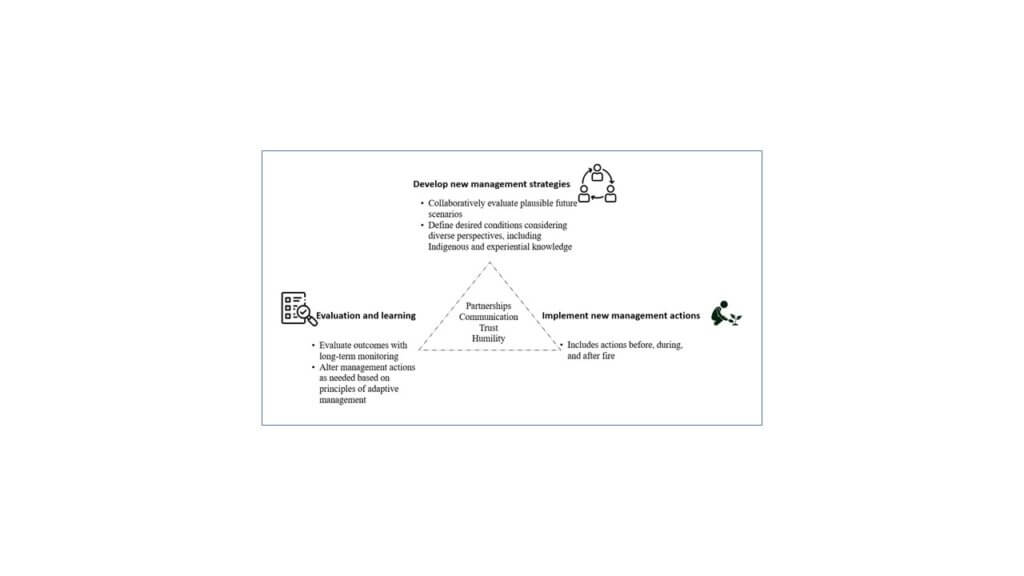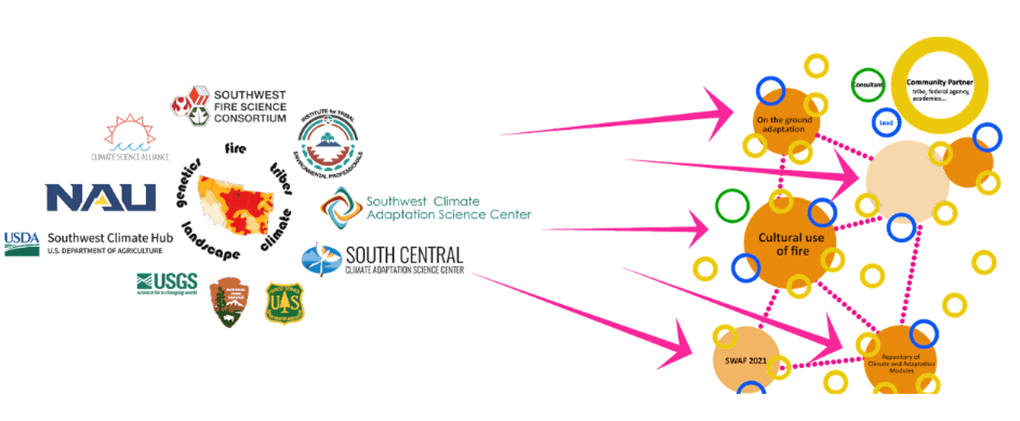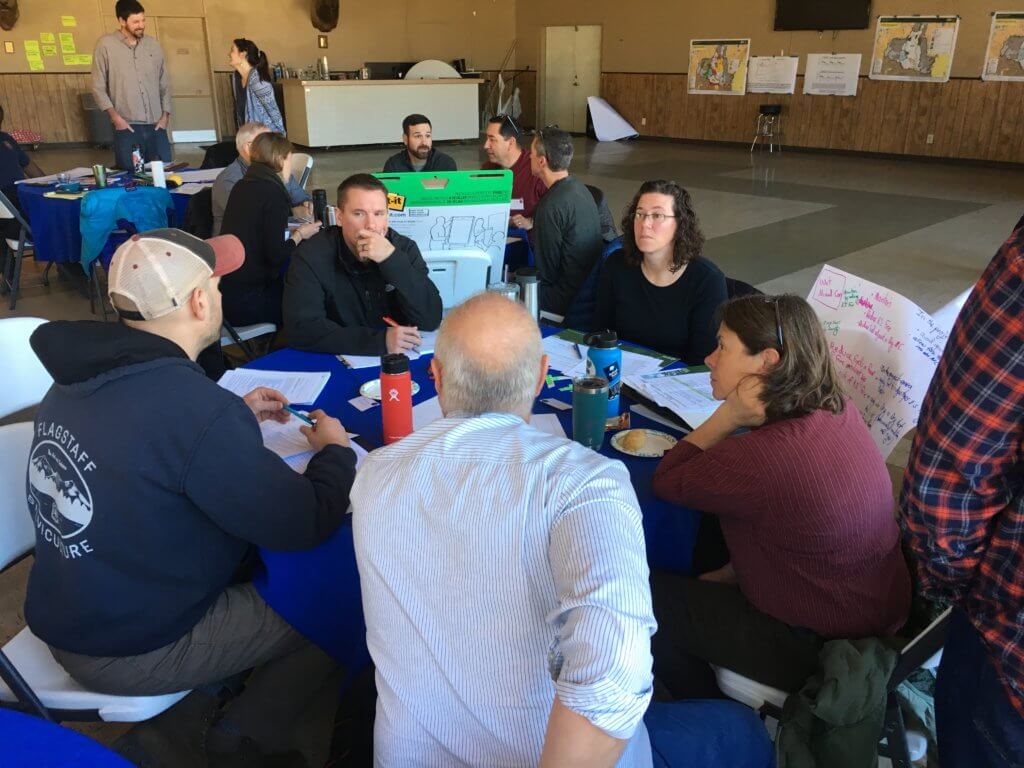FIRE & CLIMATE 2022
Reimagining science, management, and culture
An emerging framework for adapting to changing fire regimes
BY MOLLY HUNTER, ED BRUNSON, KAREN DANTE-WOOD, CAROLYN ENQUIST, KEVIN HIERS, AND SCOTT GOODRICK
An emerging framework for science funding organizations to advance the adoption of innovative management approaches to address changing fire regimes.
Scientists and managers are exploring how to incorporate climate change into restoration and fire management planning on the Kaibab Plateau during a workshop sponsored by the Southwest FireCLIME project.
The Southwest Fire Climate Adaptation Partnership (SWFireCAP) is open and inclusive and operates with action-focused roundtable teams with capacity to tackle one or multiple objectives.
The impacts of climate change on fire regimes are currently being realized through lengthening wildfire seasons, more extreme fire events, and restricted opportunities for conducting prescribed burning.
As the climate continues to change, land managers will be increasingly challenged to develop and adopt management strategies that facilitate societal and ecological adaptation to changing fire regimes.
In some cases, such strategies may include increasing the pace and scale of actions proven to increase social and ecological resilience, such as understory thinning, prescribed burning, cultural burning, or post-fire restoration.
Under extreme scenarios, climate change may significantly reduce the relevance of historical conditions or experiential knowledge to current management strategies, and novel management approaches may be needed.
However, changing the scale of current management approaches or adopting new strategies is challenged by high degrees of uncertainty in outcomes, societal expectations, resource constraints, and longstanding organizational policy, culture, and norms.
Recognizing the challenges society and ecosystems face with changing fire regimes, many science funding organizations invest in research related to fire and climate change. Yet, the scale, complexity, and difficulty associated with addressing changing fire regimes means that no one funding organization can address the multitude of science needs on its own.
Partnerships among science funding organizations are critical for leveraging resources and expertise of different organizations, facilitating cross-disciplinary science, and engaging with different science end users.
In addition, new models of science funding that support science co-production, stakeholder engagement, and science communication may be needed to accelerate the pace of adopting innovative approaches to addressing changing fire regimes.

adoption of innovative management approaches to address changing fire regimes.
Recognizing this need, a new partnership among the Joint Fire Science Program (JFSP), the JFSP Fire Science Exchange Network, the U.S. Forest Service, U.S. Geological Survey (USGS) Wildland Fire Science Program, and the USGS Climate Adaptation Science Centers has been exploring the science needs to collectively address changing fire regimes and developing a framework for advancing implementation of innovative management approaches to inform future science funding opportunities (Figure 1).
To inform the development of this framework, we hosted two workshops in conjunction with conferences hosted by the Association for Fire Ecology and the International Association for Wildland Fire. The workshops included scientists, practitioners, Tribal members, and boundary spanners working at the nexus of climate change and fire. Participants represented academia, federal, state, and local government, Tribal organizations, and non-governmental organizations and came from several regions of the United States, as well as Australia and Canada. We asked workshop participants about innovative management strategies, enabling conditions for advancing adaptation, and science needs. During the workshop presentations, panel discussions, and open dialogue, several themes emerged that we incorporated into the framework.
The framework begins with the development of new management strategies meant to accelerate adaptation to changing fire regimes. Those strategies must be based on an articulation of desired conditions that incorporate diverse perspectives. Critically, these perspectives should include those with experiential knowledge and Indigenous cultures, who both have a deep history and knowledge of land stewardship under changing conditions.
The desired conditions also need to be feasible, given how we expect ecosystems and fire regimes to respond to changing climate. Landscape and ecosystem models are important tools in this respect, for evaluating a range of plausible future scenarios. This initial step of identifying new management approaches is not trivial, as there may be a high degree of uncertainty in the outcomes, risk of unintended consequences, or tradeoffs in various approaches for protecting different social or ecological values. Thus, it is critical that the process of identifying new approaches to management, including modeling potential future scenarios and incorporating diverse perspectives, be done with partnerships among scientists, managers, practitioners, and others who have a deep interest in the outcomes of management interventions. Thus, any science funding opportunity should include support for the hard work that goes into building the trust and commitment that sustains these partnerships into the future.

Once a strategy is identified, the next step is to implement the strategy, at least on an experimental basis. These adaptation strategies could be actions that occur before, during, or after a wildfire. In our workshops, participants identified several adaptation strategies that already are being implemented and those that may require additional experimentation or policy-based changes. These included reintroduction of cultural burning practices, prescribed burning outside of typical burning seasons, planting drought-adapted tree varieties after wildfire, or using robotics for long-distance water transport to critical areas.
Some strategies also entailed increasing the pace and scale of adaptation strategies already proven to be effective in increasing resilience to wildfire or adopting such practices in areas where they are not currently used. This included practices such as understory thinning, prescribed fire, invasive plant control, and utilizing wildfire for resource benefit.
During this stage, partnerships among scientists and managers are also critical for identifying common enabling conditions to implement new strategies and replicating those conditions across landscapes.
Even with buy-in from diverse groups on newly developed management strategies, there will be uncertainty in the outcomes of implementing novel management approaches, especially under changing climate conditions. Thus, it will be critical to implement long-term monitoring plans that evaluate short-, medium- and long-term outcomes of management interventions.
Implementing these monitoring plans using the principles of adaptive management will be critical for understanding and learning from the successes and failures of new management approaches. Partnerships between scientists and managers are also needed at this stage to identify appropriate metrics to evaluate outcomes and appropriate monitoring protocols.

into restoration and fire management planning on the Kaibab Plateau
during a workshop sponsored by the Southwest FireCLIME project.
Partnerships at multiple levels are necessary to accelerate the adoption of innovative, science-based adaptive management approaches. As mentioned earlier, partnerships among scientists and practitioners are critical at every stage of this framework to assure science being conducted is actionable, can be readily translated to non-scientists, and, in turn, are incorporated into management decision making.
Partnerships among land managers, scientists, and stakeholders are necessary to ensure diverse perspectives are considered and the broader public supports land management actions.
Partnerships among science-funding organizations are needed to leverage resources, avoid duplication of effort, and create opportunities for innovation.
While there is wide recognition that the pace and scale of management efforts need to increase dramatically, there is also recognition that the work of developing and maintaining partnerships often must occur on much smaller, more local scales.
Several factors were identified that science funding organizations could consider to support local partnerships and collaboratives while also facilitating the implementation of management strategies across broad scales. These factors include investing in organizations that work within communities and have well established trust and relationships with stakeholders and investing in liaisons who can work across organizations and disciplines. It also will be critical to support the development of communication tools and strategies designed for the broader public, to gain broader support for management actions and trust in land management organizations.
The organizations in this partnership are well suited to collectively implement and support this framework. The Joint Fire Science Program is renowned for funding applied fire science that has been incorporated into fire and fuels management decisions and invests heavily in science communication and dissemination through the Fire Science Exchange Network. The USGS Climate Adaptation Science Centers (CASCs) also have a long history of engaging in science co-production, incorporating stakeholder engagement in science funding, and collaboration with Tribal partners.
Furthermore, many scientists within the U.S. Geological Survey have expertise in ecosystem modeling, which is critical for identifying plausible future scenarios. The recently completed USGS Wildland Fire Science Strategic Plan includes a modeling collaborative that could provide crucial support for implementing this framework. The U.S. Forest Service manages much of the land where this work would be implemented, and its recently published 10-year strategy for confronting the wildfire crisis builds off the National Cohesive Wildland Fire Management Strategy and Shared Stewardship agreements to work with partners in focusing fuels, forest health, and fire management in a manner that is strategic, science-based, and matches the scale of the wildfire problem.
In the coming months, our partnership will further develop this framework and incorporate it into a science strategy to inform future science funding opportunities.
Examples of innovative partnerships addressing fire and climate change highlighted in recent workshops
- While fire is a natural process in many Alaska environments, climate change is causing fires to become larger and more frequent. In the Yukon Flats National Wildlife Refuge, this changing fire regime has profound implications for ecosystems, carbon storage, and human health, particularly for remote Indigenous communities within the refuge boundary. To gather diverse perspectives on developing new fire management strategies in the face of changing conditions, the refuge convened a workshop with managers, boundary spanners, scientists, and community members to explore science, fire management challenges, and community needs. Setting a workshop tone of transparency, humility, and openness (before, during, and after the event) was key to establishing trust with participants and facilitated an open dialogue with diverse perspectives represented. The refuge manager will use the information gathered to broaden conversations to ultimately adapt existing refuge management plans. For more information visit frames.gov/event/574183.
- The Southwest FireCLIME project (funded by JFSP) represents an example of a project that incorporates manager science partnerships to assess plausible future scenarios, desired conditions, and potential management actions. The project included a workshop hosted by project leaders in partnership with the Northern Institute of Applied Climate Science, during which scientists and managers considered how to incorporate climate change into restoration and fire management planning on the Kaibab Plateau. Allowing scientists and managers to explore how climate change may impact fire regimes and ecosystems at the scale of an individual project was critical for changing managers’ perceptions about trying new adaptive management approaches. For more information visit swfireclime.org.
- The Southwest Fire Climate Adaptation Partnership (SWFireCAP) is an example of a collaborative that includes diverse perspectives in identifying adaptation strategies and opportunities in the southwest. Jointly launched by the Southwest CASC and the Southwest Fire Science Consortium, the partnership aims to bridge the gap between fire and climate adaptation practitioners and advance fire and climate adaptation in the southwestern United States. The partnership is open and inclusive, with participation from universities, federal agencies, non-governmental organizations, and Tribal organizations. The partnership operates with self-governing roundtable teams, which are action-focused groups with the capacity to tackle one or multiple objectives, including identifying cultural burning needs, documenting examples of on-the-ground adaptation, and compiling training opportunities. Find out more at swfirecap.org
For more information visit:
Joint Fire Science Program https://www.firescience.gov/
Climate Adaptation Science Centers https://www.usgs.gov/programs/climate-adaptation-science-centers
USGS Fire Science https://www.usgs.gov/special-topics/wildland-fire-science
USFS Fire Research https://www.fs.usda.gov/science-technology/fire/fire-research
Fire Science Exchange Network https://www.firescience.gov/JFSP_exchanges.cfm
Southwest FireCLIME https://swfireclime.org/
Southwest FireCAP https://www.swfirecap.org/
USFS 10-year Wildfire Strategy https://www.fs.usda.gov/managing-land/wildfire-crisis
USGS Wildland Fire Science Strategic Plan https://pubs.er.usgs.gov/publication/cir1471
ABOUT THE AUTHORS
Molly Hunter is the science advisor for the Joint Fire Science Program. For more than 10 years Hunter has assisted the program in developing science strategies and plans for a variety of fire-related topics, including the nexus of fire and climate change. Hunter is based at the University of Arizona where she is also associate research professor
Ed Brunson is the Joint Fire Science Program manager. Brunson has worked with the program since 2015, serving in positions as deputy program manager and acting communications director. Brunson formerly worked as Bureau of Indian Affairs regional fuels specialist and regional fire ecologist.
Karen Dante-Wood is the technology transfer specialist for the Joint Fire Science Program, guiding and supporting activities for the Fire Science Exchange Network and developing fire science and technology transfer products. Prior to joining the program, Dante-Wood held positions with the National Wildlife Federation, Environmental Protection Agency, and the U.S. Forest Service.
Carolyn Enquist is the acting director and deputy director of the Southwest Climate Adaptation Science Center. For more than two decades Enquist has worked at the nexus of science and practice with a focus on the biodiversity impacts of climate change, practical guidance for conducting vulnerability assessments, and the practice of climate adaptation planning and implementation. Enquist currently serves as lead author on the IPCC Working Group 2 AR6 report and is author on the southwest chapter of the most recent National Climate Assessment, where she is leading the section on wildfire.
Kevin Hiers is the acting deputy wildland fire science coordinator at U.S. Geological Survey, where he assists in implementing USGS strategic research priorities, interagency fire science partnerships, and planning fire science support for Department of Interior fire management programs. Hiers’ home agency is Tall Timbers Research Station, and he has worked at the interface of fire management and research for 27 years.
Scott Goodrick is a research meteorologist with the U.S. Forest Service Southern Research Station, where he studies fire-atmosphere interactions, smoke dispersion, and how climate influences the occurrence of forest fires. Goodrick is also a member of the Joint Fire Science Program governing board.
